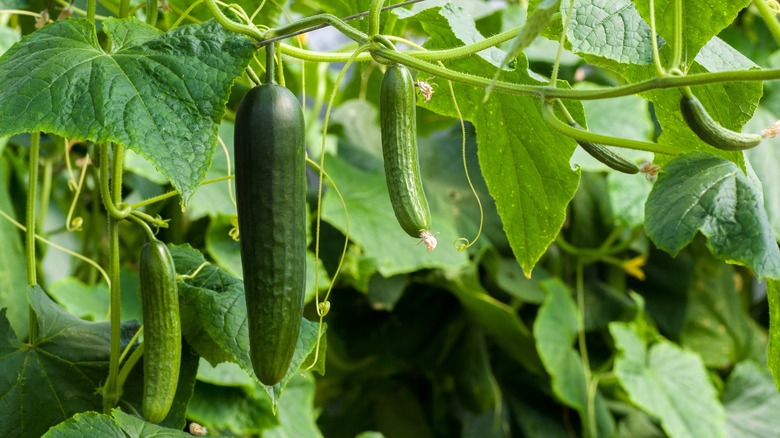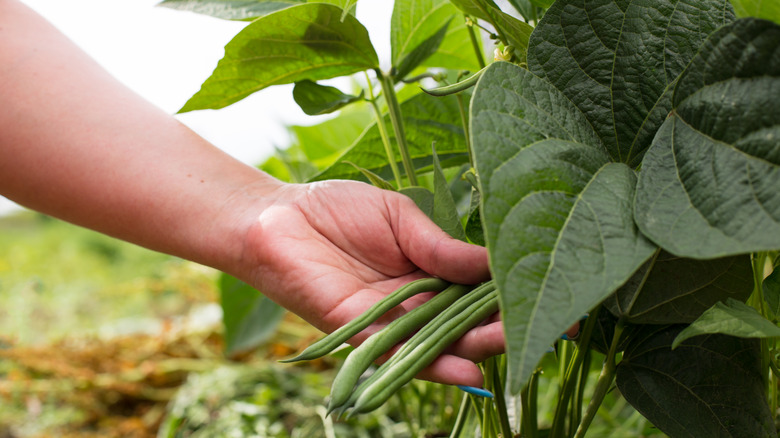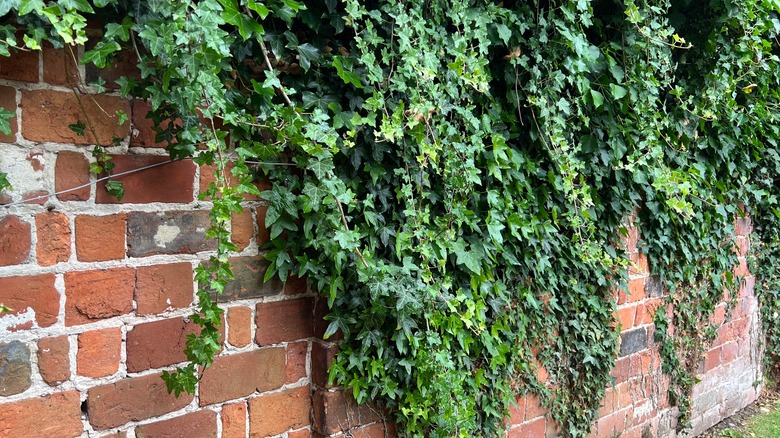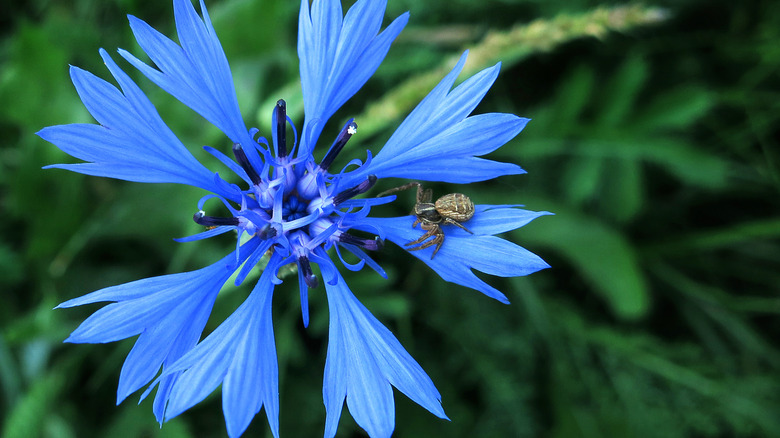15 Plants That Are Attracting Spiders To Your Yard & Garden
While spiders are beneficial to have in your garden as they feed on pests such as aphids, beetles, wasps, caterpillars, and mosquitoes, if you have a fear of them, make a note to avoid the plants that are going to attract them to your yard. On the flip side, you might be interested in learning that spiders are generally beneficial in the garden, consuming more insects than other creatures like birds or bats. If you still want to avoid attracting spiders to your yard and garden, we have gathered 15 plants that are more likely to attract them than others.
Spiders are particularly fond of taller plants, like sunflowers and corn stalks, as they allow the arachnids to spin their webs high above the ground, where they're likely to easily catch flying insects. Many grassy plants will also provide the perfect habitat for spiders to spin their webs and lie in wait for unsuspecting insects to fall prey to their sticky trap. Additionally, thorny plants are likely to attract spiders because they provide protection from predators such as birds. Even plants commonly grown indoors, like ferns, bromeliads, and spider plants, may attract spiders if you place them outdoors during the warmer weather. Plus, your houseplants could attract this unwanted pest into your home anyway. If you don't want spiders invading, consider replacing the following plants that might be attracting arachnids to your garden.
1. Sunflowers
Who doesn't love the bright, happy faces of sunflowers growing in a summer garden? Many sunflower species grow quite tall, towering above the rest of the blooms and making you smile every time you see them peeking up. However, thanks to their tall stature, they may attract web-spinning spiders, who like to make their webs up high to increase their chances of trapping other insects that may visit the sunflowers for their nectar, such as bees and wasps. In fact, planting this gorgeous flower may result in an unwanted spider problem in your garden.
2. Corn plants
Much like sunflowers, corn plants grow straight and tall, making them a perfect candidate for hosting web-spinning spiders like orb weavers. These spiders find the unyielding corn stalks ideal for giving support to their webs. Then, they can sit and wait for unsuspecting pollinator insects to come along and get caught in the sticky fibers. Even when the corn stalks wave in the breeze, they won't bend and break, which makes them the ideal foundation to support the spider's web, thereby keeping the arachnid's home safe.
3. Tomato plants
Many tomato plants can also grow quite tall, especially if you're growing the indeterminate types and providing plenty of support. These can also provide the perfect habitat for web-spinning spiders who are looking for a safe and secure place to spin their webs. Tomato plants offer plenty of hiding spots for spiders with lush, dense foliage. This means that spiders can spin their webs undisturbed by predators, such as birds, and sit and wait for insects to come by and get caught in their sticky trap.
4. Cucumber plants
As you would know, spiders' primary food source is insects, spinning their webs to catch unsuspecting prey. What you might not know is that spiders are very fond of a particular insect: cucumber beetles, so the cucumber plants you love growing in summer are likely to also attract spiders. Actually, if you can handle having the spiders around, they are likely to be incredibly beneficial in protecting your cucumber plants from being damaged. In some cases, pests have been known to abandon an area where spiders have taken up residence.
5. Pole beans
Pole beans are usually grown on a trellis, and their lush, green foliage provides plenty of hiding spaces for spiders, so when you go out to pick some crisp, fresh beans for dinner, keep an eye out for a spider or two that may have found the perfect hiding spot among your beans. The strong structures that support the climbing beans also provide excellent support for spiders to spin their webs on. If you have thrips or beetles in your garden, these will provide a good food source for any spiders lurking among your beans.
6. Foxgloves
Foxgloves are gorgeous flowering plants that will brighten up any garden with their bright floral colors of white, pink, and purple and their stately height of up to 5 feet, but before planting these beauties in your garden, be aware that they can also attract spiders. The tall stems provide a nice solid structure for the spider's webs, and the blooms will attract many different pollinators, including bees and butterflies, providing an excellent smorgasbord for the spiders waiting patiently for their prey. You should also know that this plant is toxic to humans and pets.
7. Hollyhocks
Hollyhocks are another gorgeous flowering plant that can grow to a stately height of up to 8 feet, making them perfect for spiders who are looking for strong supports on which to build their webs. Like many other nectar-rich flowers, these beauties will attract pollinators and provide an excellent food source for any resident spiders that have made these plants their home. It's also quite interesting to note that as the cycle continues, the spiders will also become a food source for insect-eating birds.
8. English ivy
The common English ivy, often found growing on fences and walls of older homes, is another plant that spiders will favor because the very dense foliage offers plenty of good hiding spaces. In fact, you should really avoid planting this spider-attracting plant near your home, especially if you don't want spiders coming indoors. While many people can tolerate spiders in the garden and even welcome them, most people don't want arachnids inside their houses, which isn't the best place for them anyway.
9. Ferns
Lush, green ferns often grow as understory plants in forests around the world. This creates the perfect habitat for spiders who prefer darker spaces where they can hide and watch for the flying and crawling insects that also like to inhabit these types of environments. So, if you happen to have a shady area in your garden that you've planted with a variety of different lush, green ferns, be aware that there might also be spiders lurking among the foliage and waiting for their next meal to come flying or crawling past.
10. Bromeliads
Bromeliads are a stunning collection of plants that usually thrive in moist and shaded environments. They're often found growing naturally in tropical regions and rainforests. This environment in which bromeliads like to grow is also what spiders tend to prefer, so it's natural that these plants would attract them. The solid structure of the leaves allows spiders to spin their webs effortlessly, and the leaves are arranged quite densely, creating perfect hiding spaces for hunting spiders that might be lying in wait for other insects to come by.
11. Pitcher plants
You would imagine that an insect-attracting plant, like the stunning pitcher plant, would also attract spiders, and you would be right. In fact, this plant is especially attractive to crab spiders who sit in wait to feed on visiting insects that are drawn to this plant. However, these carnivorous plants are mostly grown only by collectors because they prefer specific growing conditions, like plenty of moisture and sandy soils poor in nutrients. That's because pitcher plants actually absorb nutrients from the insects they trap.
12. Trumpet vine
The trumpet vine is native to the Southeastern United States and is popular with gardeners who want to attract hummingbirds. But before you dash out to purchase one of these stunning plants for your garden, be aware that it can also attract a range of insect pests, such as scale, mealybugs, and whiteflies. In turn, this means that the trumpet vine is also attractive to spiders, who will enjoy the feast that these insects can provide. Plus, the plant contains a sap that can cause minor skin irritation when it comes into contact with exposed skin.
13. Roses
If you've ever grown roses in your garden, you'll know that they attract lots of aphids that like to feast on the tender young growth. This means that spiders are often drawn to your rose plants due to the very handy food supply. It's quite common for spiders to spin their webs within the strong stems of the rose bushes to catch flying and crawling insects for their evening meal. Even non-web-spinning crab spiders find it difficult to resist roses because these plants attract so many other insects that they can feed on.
14. Cornflowers
In the world of arachnids, it's common for crab spiders to frequent nectar-filled flowers and wait for pollinators such as bees to visit the flowers to collect the sweet nectar. Beautiful and colorful cornflowers are one such bloom that will attract not only pollinators but also the spiders that like to feast on them. These delightful flowers are also known to attract songbirds who love the nectar and pick up the spiders to feed to their young, which make a good source of protein for the baby birds.
15. Chamomile
Chamomile flowers are known to be highly attractive to pollinators, which means that spiders, such as the crab spider, will often be drawn to these pretty flowers when they're growing in your garden. The spiders will hide under the petals, waiting for an unsuspecting insect to come along. Chamomile is a popular garden flower that is often planted with other colorful blooms in meadow gardens. However, you should be aware that it can cause contact dermatitis in some people, while the flowers are also commonly used to make tea.















